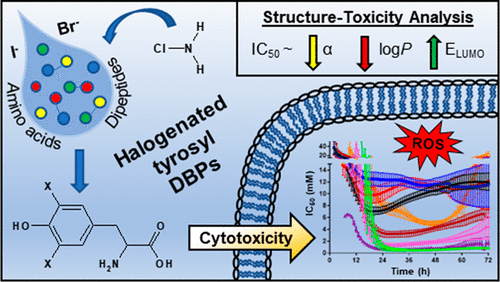当前位置:
X-MOL 学术
›
Chem. Res. Toxicol.
›
论文详情
Our official English website, www.x-mol.net, welcomes your feedback! (Note: you will need to create a separate account there.)
Cytotoxicity of Halogenated Tyrosyl Compounds, an Emerging Class of Disinfection Byproducts.
Chemical Research in Toxicology ( IF 4.1 ) Pub Date : 2020-04-01 , DOI: 10.1021/acs.chemrestox.0c00049 Dayong Tian 1, 2 , Birget Moe 1, 3 , Guang Huang 1 , Ping Jiang 1 , Zong-Chao Ling 3 , Xing-Fang Li 1
Chemical Research in Toxicology ( IF 4.1 ) Pub Date : 2020-04-01 , DOI: 10.1021/acs.chemrestox.0c00049 Dayong Tian 1, 2 , Birget Moe 1, 3 , Guang Huang 1 , Ping Jiang 1 , Zong-Chao Ling 3 , Xing-Fang Li 1
Affiliation

|
Halogenated amino acids and peptides are an emerging class of disinfection byproducts (DBPs), having been detected in drinking water and in washed food products. However, the toxicological significance of these emerging DBPs remains unclear. In this study, the cytotoxicity of eight halogenated tyrosyl compounds was investigated in Chinese hamster ovary (CHO) cells using real-time cell analysis (RTCA). Dihalogenated tyrosyl compounds are more cytotoxic than their monohalogenated analogues. The cytotoxicity of the dihalogenated compounds is associated with their ability to induce intracellular reactive oxygen species (ROS), suggesting that oxidative stress is an important toxicity pathway of these compounds. Pearson correlation analysis of the cytotoxicity (IC50 values) of these compounds with eight physicochemical parameters showed strong associations with their lipophilicity (logP) and reactivity (polarizability, ELUMO). Finally, cytotoxicity testing of the concentrated extracts of a chloraminated mixture of eight dipeptides with bromide or iodide showed the cytotoxicity of these mixtures in the order: iodinated peptides > brominated peptides ≥ chlorinated peptides. These results demonstrate that halogenated peptide DBPs are toxicologically relevant, and further research is needed to understand the implications of long-term exposure for human health.
更新日期:2020-04-23


























 京公网安备 11010802027423号
京公网安备 11010802027423号